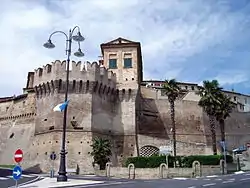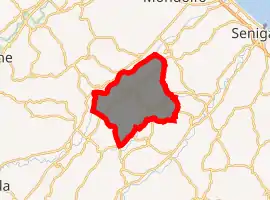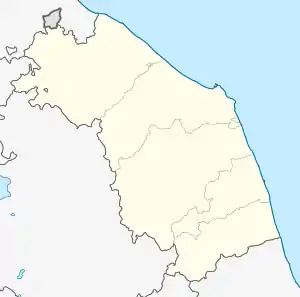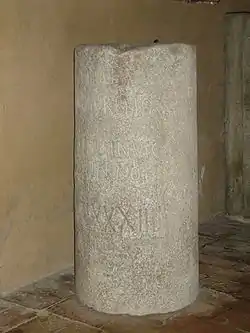Corinaldo
Corinaldo is a town and comune in the Province of Ancona, within the Marche region of central Italy. It is about 80 kilometres (50 mi) north of Assisi. It is home to well-preserved 14th-century walls, and was the birthplace of Saint Maria Goretti; it is also the site of a Halloween festival held every October.
Corinaldo | |
|---|---|
| Comune di Corinaldo | |
 Walls of Corinaldo. | |
| Motto(s): Cineribus orta combusta revixi | |
Location of Corinaldo 
| |
 Corinaldo Location of Corinaldo in Italy  Corinaldo Corinaldo (Marche) | |
| Coordinates: 43°38′57″N 13°2′54″E | |
| Country | Italy |
| Region | Marche |
| Province | Ancona (AN) |
| Frazioni | Cesano, Madonna del Piano, Nevola, San Bartolo, San Domenico, Santa Maria, Sant'Isidoro, San Vincenzo, Ville |
| Government | |
| • Mayor | Matteo Principi |
| Area | |
| • Total | 48.32 km2 (18.66 sq mi) |
| Elevation | 203 m (666 ft) |
| Population (31 December 2017)[2] | |
| • Total | 4,949 |
| • Density | 100/km2 (270/sq mi) |
| Demonym(s) | Corinaldesi |
| Time zone | UTC+1 (CET) |
| • Summer (DST) | UTC+2 (CEST) |
| Postal code | 60013 |
| Dialing code | 071 |
| Patron saint | St. Anne |
| Saint day | July 26 |
| Website | Official website |
It is a wine country (its Verdicchio is famous). Corinaldo is included in the association "I borghi più belli d'Italia" and in 2007 it was voted "Italy's prettiest village"

Main sights
The walls
The imposing walls preserve all the typical elements of the Medieval period such as murder holes, embrasures, loopholes, moats and towers telling the tales of glorious battles of the past. Following the external path of the walls, which is about 800 meters long, it is possible to visit 3 of the 4 towers near the castle entrances. The three entrances are: Porta Nova (New Gate), Porta del Mercato (Market Gate), Porta San Giovanni (Saint John's Gate).
The polenta well
Located at the center of La Piaggia (a suggestive staircase of 104 steps) there is a well. The actual well was rebuilt in the 80s in the same place where the original one was, built in the 15th century by the tyrant of Corinaldo, Antonello Accattabriga. The original one was used as aqueduct and destroyed at the end of the 19th century, because it was no longer necessary. The well is linked with a traditional folk story: a long time ago, a man was climbing La Piaggia staircase street with a sack of corn flour on his shoulders. Once he reached the well, he put the sack on the well's edge to catch his breath but unfortunately the sack tumbled down into it. The poor man tried to save it and went down into the well himself. Starting from this point of the story, the oral tradition over time created many different versions of what happened next: the people watching the scene started to say that he was eating polenta in the well, while someone else thought that the polenta needed a few sausages to be more tasteful and others went to the well. This rumor was probably fostered by the military enemies of Corinaldo to discredit the citizens.
The fig cannon
The fig cannon is another popular folk tradition belonging to Corinaldo's citizens: the rivalry between Corinaldo and Montenovo (old name for Ostra Vetere) had been long-standing. Since the citizens of Corinaldo had long desired to win this rivalry, they had an ingenious idea. They used a trunk of fig, and they made a cannon out of this wood, which is very fragile. The day they shot with the cannon, many people crowded onto the city walls to witness the fall of Montenovo. The seven most courageous citizen held the cannon while the commander lit the fuse. There was a tremendous boom and when the smoke faded away, the seven were fallen dead. The commander then exclaimed: "If seven people died here, just imagine how many died in Montenovo!". A reconstruction of the fig cannon can be visited inside the town hall building.
Museums
The town art museum is the Pinacoteca Claudio Ridolfi.
Twin towns
 Arcore, Italy
Arcore, Italy Nettuno, Italy
Nettuno, Italy San Benedetto dei Marsi, Italy
San Benedetto dei Marsi, Italy
References
- "Superficie di Comuni Province e Regioni italiane al 9 ottobre 2011". Istat. Retrieved 16 March 2019.
- "Popolazione Residente al 1° Gennaio 2018". Istat. Retrieved 16 March 2019.
External links
- http://www.missstrega.it/ - Official website for the Corinaldo Halloween Festival
- Awarded "EDEN - European Destinations of Excellence" non traditional tourist destination 2008
